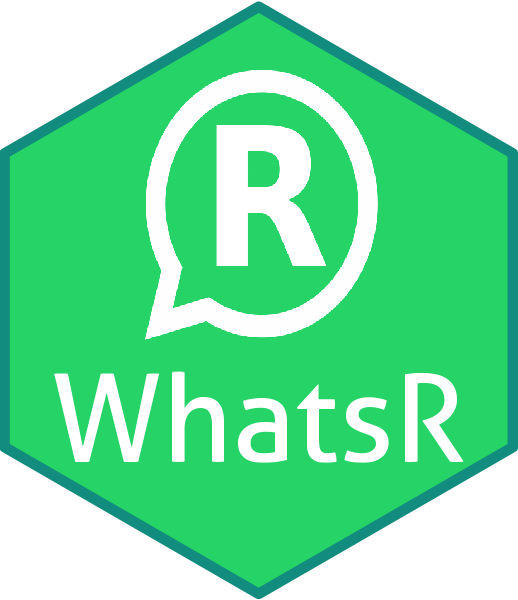The hardware and bandwidth for this mirror is donated by METANET, the Webhosting and Full Service-Cloud Provider.
If you wish to report a bug, or if you are interested in having us mirror your free-software or open-source project, please feel free to contact us at mirror[@]metanet.ch.

This is an R-package to import exported WhatsApp chatlogs, parse them into a usable dataframe format and thereby enable further analysis. This parser was built with the goal to work with chat logs extracted on Android as well as iOS devices, run on Linux, Mac and Windows, and to be able to handle multiple languages. Currently, only English and German are supported, but in principle, other languages could be added relatively easily (see below). The repo also contains a function to scrape and update the emoji_dictionary, should new emoji be added to WhatsApp in the meantime.
RTools needs to be installed and
workingRJava package needs to be installed and
workingragg package and you need
to set your graphics backend to AGG (In Rstudio: Tools >
Global Options > Graphics > Backend) # for the most up-to-date GitHub version
library(devtools)
devtools::install_github("gesiscss/WhatsR")
# from CRAN
install.packages("WhatsR")
# creating simulated chatlog (saved in working directory)
simulated_raw_chat <- create_chatlog(language = "english")
# parsing it
simulated_parsed_chat <- parse_chat("Simulated_WhatsR_chatlog.txt")
# plotting emojis contained in chat
plot_emoji(simulated_parsed_chat, plot="bar")
For Android Phones: https://faq.whatsapp.com/en/android/23756533/?category=5245251
For Iphones: https://faq.whatsapp.com/en/iphone/20888066/?category=5245251#email
# parsing it
simulated_parse_chat <- parse_chat("PATH/TO/YOUR/EXPORTED/FILE.txt")
# plotting it
plot_emoji(simulated_parse_chat, plot="bar")If you are using this package for your research, please cite it accordingly. You get the citation as a BibTex by running
citation("WhatsR")To cite package ‘WhatsR’ in publications use:
Kohne J (2023). “WhatsR - An R-package for parsing, anonymizing and visualizing exported
WhatsApp chat logs.” doi:10.5281/zenodo.7875622, <https://doi.org/10.5281/zenodo.7875622>.
A BibTeX entry for LaTeX users is
@Misc{,
title = {WhatsR - An R-package for parsing, anonymizing and visualizing exported WhatsApp chat logs},
doi = {10.5281/zenodo.7875622},
url = {https://doi.org/10.5281/zenodo.7875622},
year = {2023},
author = {J. Kohne},
}
Currently, only chats exported from phones set to German or
English are supported. Other languages can be added by
appending the languages.csv file with the necessary regular
expressions to differentiate system messages from user generated
content. In addition, parse_chat would need to be adapted
and additional tests would have to be added. If you would like to add a
language, please consider doing so via a pull request in this
repository.
The package also includes some functions to compute additional
metrics and visualize them. We will provide some basic examples for
chats with two participants and for group chats with multiple
participants here, for a complete overview, you can check the documentation or the figure
section. The used chat is a chat that was parsed with the
anonimize = TRUE parameter to exclude participant names.
All plotting functions include multiple types of plots and additional
parameters to restrict the range of the data.
summarize_tokens_per_person(data)$`WhatsApp System Message`
$`WhatsApp System Message`$Timespan
$`WhatsApp System Message`$Timespan$Start
[1] "2020-10-27 18:51:00 UTC"
$`WhatsApp System Message`$Timespan$End
[1] "2022-10-06 19:57:00 UTC"
$`WhatsApp System Message`$TokenStats
Min. 1st Qu. Median Mean 3rd Qu. Max.
1 1 1 1 1 1
$Person_1
$Person_1$Timespan
$Person_1$Timespan$Start
[1] "2020-10-27 18:51:00 UTC"
$Person_1$Timespan$End
[1] "2022-10-06 19:57:00 UTC"
$Person_1$TokenStats
Min. 1st Qu. Median Mean 3rd Qu. Max.
1.000 1.000 6.000 9.195 13.000 169.000
$Person_2
$Person_2$Timespan
$Person_2$Timespan$Start
[1] "2020-10-27 18:51:00 UTC"
$Person_2$Timespan$End
[1] "2022-10-06 19:57:00 UTC"
$Person_2$TokenStats
Min. 1st Qu. Median Mean 3rd Qu. Max.
1.00 1.00 6.00 10.75 14.00 407.00
Distribution of sent Messages.
plot_messages(data, plot = "cumsum", exclude_sm = TRUE)_cumsum.png)
Distribution of sent Tokens (words).
plot_tokens(data, plot = "violin", exclude_sm = TRUE)_violin.png)
Distribution of sent Tokens per Person over time
plot_tokens_over_time(data, plot = "hours", exclude_sm = TRUE)_hours.png)
Wordcloud of sent tokens, seperately for each participant.
plot_wordcloud(data, comparison = TRUE, exclude_sm = TRUE, font_size=50, min_occur= 300)_comparison.png)
Occurrences of keywords in the chat. Example keyword is “Weihnachten” (Christmas).
plot_lexical_dispersion(data,keywords = c("weihnachten"), exclude_sm = TRUE).png)
Amount of sent Links per person and over time
plot_links(data, plot = "heatmap", exclude_sm = TRUE)_heatmap.png)
Amount of sent Smilies over time
plot_smilies(data, plot = "cumsum", exclude_sm = TRUE)_cumsum.png)
Amount of sent emoji per person
plot_emoji(data, plot = "splitbar", min_occur = 50, exclude_sm = TRUE)_splitbar.png)
Plotting mentioned locations by persons
Currently disabled until changes in ggmap make it to CRAN
Plotting time it takes to respond
plot_replytimes(data, type = "replytime", exclude_sm = TRUE).png)
Amount of sent Media files per person and over time
plot_media(data, plot = "bar", exclude_sm = TRUE)_bar.png)
Interactive network of chat participants. A connection represents a response to a message. Each Message is interpreted as a response to the previous message. Consecutive messages by the same chat participant are summarized into one “session”. The shown plot is simple image, the actual output is an interactive HTML object, see man folder.
plot_network(data)_image.png)
These binaries (installable software) and packages are in development.
They may not be fully stable and should be used with caution. We make no claims about them.